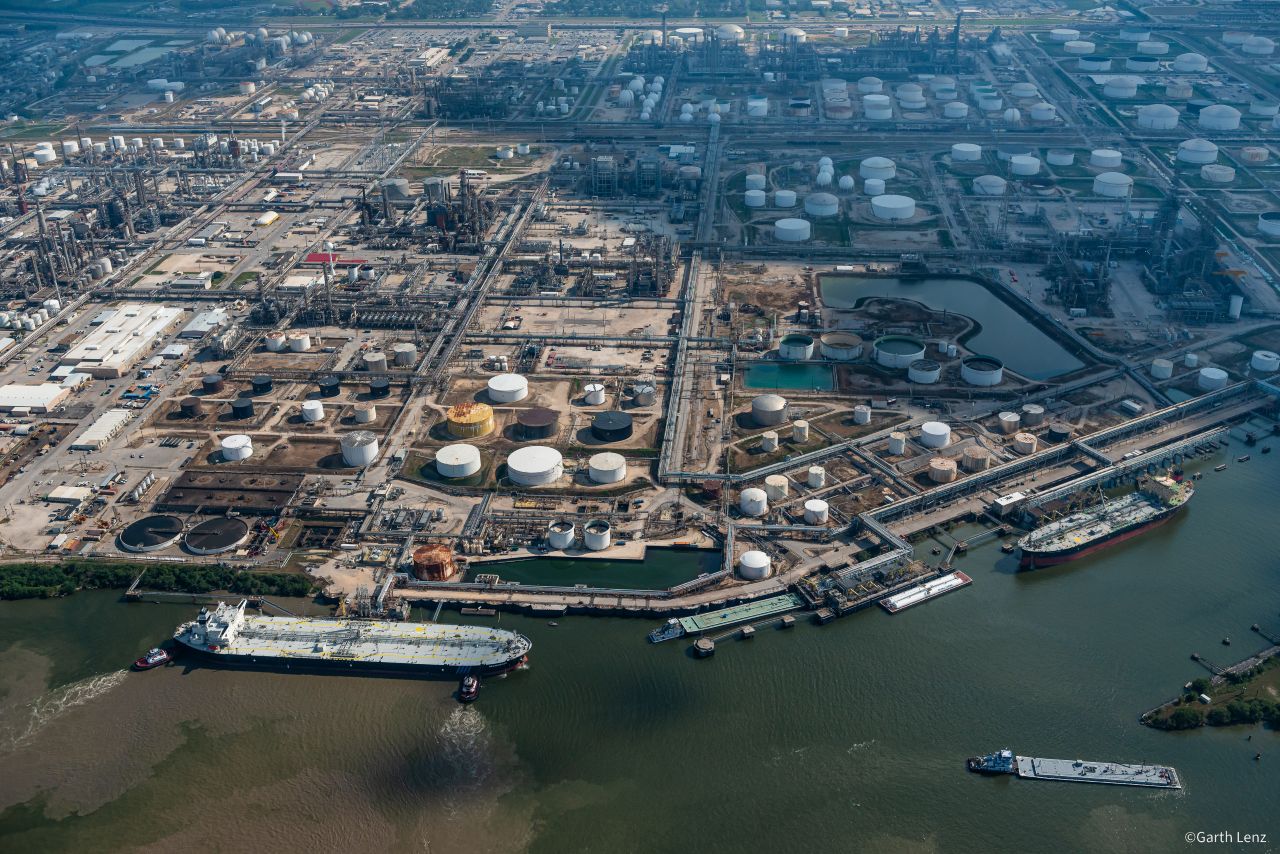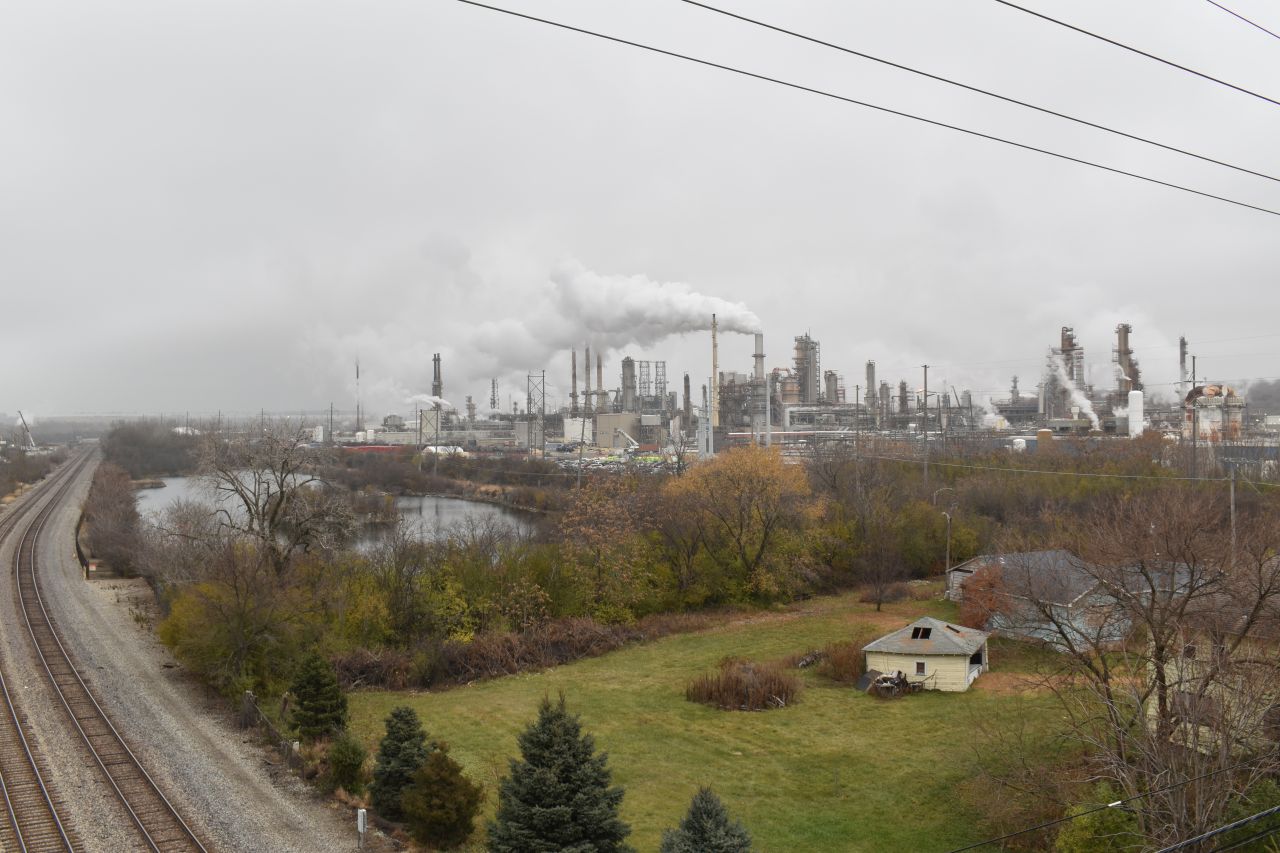In East Texas, organizers fight massive oil export pipeline planned for popular fishing grounds

PORT ARTHUR, TEXAS -- A pipeline that would help ship U.S. oil abroad is facing opposition from organizers along the Texas-Louisiana border who warn of the risk of a massive spill that could destroy popular fishing grounds.
John Beard, Jr., is the driving force behind the Save Sabine Lake coalition, made up of Beard’s Port Arthur Community Action Network, along with other state and national groups. They oppose plans by Energy Transfer Partners, one of the nation’s largest pipeline companies, to build a pipeline to carry oil from the northern U.S. and Canada to a terminal where ships could fill their holds to carry that oil abroad.
The project is part of an explosive growth in U.S. oil exports, which rose from an average of 42,000 barrels per day in 2010 to 3.3 million barrels per day in 2022, according to U.S. Energy Information Administration (EIA) figures. In 2015, Congress and President Barack Obama lifted a 40-year-old ban on most crude oil exports from the U.S., which was intended to conserve the fuel for domestic markets. The U.S. now exports more petroleum than it imports, and its largest crude oil buyers are India (14 percent), South Korea (12 percent), Canada (11 percent),the Netherlands (10 percent), and China (8 percent).
Export from the Gulf Coast region known as Texas's Golden Triangle is currently possible via tanker vessels that traverse the area's shipping lanes, rivers, and bays. One of Port Arthur’s worst oil spills in recent history was in 2010, when a shipping barge collided into an oil tanker, spilling an estimated 450,000 gallons.
Helping to facilitate that export of oil from the U.S is a rapidly expanding network of pipelines. Companies completed 14 petroleum pipeline projects covering more than 4,000 miles in 2021, including five pipelines in Texas, according to the EIA. Another six petroleum pipeline projects have been announced or completed so far in 2022, with five of these pipelines ending in Texas.
The proposed Blue Marlin offshore oil terminal project near Port Arthur would make it easier for larger ships to fill their holds in deeper Gulf waters. However, bringing oil to the terminal involves constructing 37 new miles of 42-inchdiameter pipe, which would pump 2 million barrels per day. That’s enough to fill one of the world’s largest tankers every 24 hours.
The Blue Marlin pipeline’s route would begin at Energy Transfer’s terminal in Nederland, Texas, along the west bank of the Neches River, just northwest of Port Arthur. There, a vast field of white, metal cylinders store petroleum, chemical feedstocks, and heavy oils used for fueling ships. The site is the end point of several long-haul pipelines, including the 1,172-mile Bakken Pipeline from North Dakota and the 537-mile Permian Express out of West Texas.
From the banks of the Neches River, the pipeline would cross under a series of wetlands and islands before crossing under Sabine Lake, whose center marks the boundary between Texas and Louisiana. On the Louisiana side, it would tie into the already-built Stingray natural gas pipeline system, which would be converted to use for oil.
Much of the opposition’s focus is centered on Sabine Lake, a shallow bay that averages only 6 feet deep. The bay is 15 miles across, and the pipeline would span 12 of those miles. The least salty of Texas’s eight major coastal estuaries, the lake is home to both fresh- and salt-water-loving species. On weekends, anglers line the fishing piers and seawalls of Pleasure Island, a sliver of land jutting into the bay, separated from Port Arthur by a shipping channel dug in the early 1900s.


According to Energy Transfer’s proposal to the federal government, these popular fishing spots could become coated in oil in the event of a spill, though consultants for the company called the possibility “unlikely.” One modeled accident scenario shows that a spill of 74,000 barrels in the middle of Sabine Lake could lead to dark, heavy Bakken oil coating the fishing grounds of Pleasure Island and much of the lake’s southern half.
The pipeline’s construction would also destroy 57 acres of oyster reef in Sabine Lake, according to a September 2021 report by Texas A&M University-Corpus Christi scientist Terence Palmer. These reefs are “unique amongst all North American oyster reefs in that they have not been harvested for at least 100 years,” he wrote. These reefs provide better fish habitat, better stability of the sediment, and higher water filtration rates than harvested reefs.
“The loss of any acreage of oyster reef in Sabine Lake is concerning because of the overall degradation of oyster reefs in the region, the unique nature of these reefs, and the many ecosystem services they provide,” Palmer wrote.
Other parks and refuges bordering the lake include the Sabine National Wildlife Refuge and the Lower Neches Wildlife Management Area. In a December 2020 letter to federal regulators, Texas Parks and Wildlife officials expressed“ concerns regarding potential direct, indirect, and cumulative impact to multiple habitats” of the bay and surrounding marshes.
Spills, leaks, fires, and explosions are relatively common in this part of Gulf Coast, the hub of the U.S. oil, gas, and petrochemical industry. On July 7, a natural gas line explosion in neighboring Fort Bend County led to neighborhood evacuations. In 2019, 60,000 people in Port Neches and Port Arthur were evacuated when a butadiene leak at a TPC group plant caused three massive explosions and fires that burned for a month.
John Beard, Jr., was raised in Port Arthur and attended the local Lamar State College before working 38 years in an ExxonMobil refinery. He also served nine years on the city council, representing the west side of the city with some of its largest refineries. During two meetings in Port Arthur and Bridge City, a smaller community across the Neches River, he focused mainly on pipeline company’s aggressive negotiation tactics with landowners and the risks to the local fishing grounds of a major spill.
“This is public property,” Beard said of Sabine Lake. “This is something that we all take advantage of, that we all cherish. And there’s a few who make a living at it. There’s still guys that shrimp off of Lake Sabine and catch fish for sale. If that’s disturbed, what’s that loss going to do to them? … What’s it going to do to our quality of life?”
Energy Transfer also has a hefty record of violations. During construction of its Rover natural gas line in the Midwest, the company amassed 681 permit violations, according to Reuters. In 2021, Pennsylvania Attorney General Josh Shapiro filed criminal charges against the company for drilling fluid discharges during its construction on its Mariner East pipeline.
Davis Dixon, who attended the Save Sabine Lake group’s meeting in Bridge City, worked in the refinery business before retirement and now serves as vice president of his county chapter of the Coastal Conservation Association. Dixon said his two main issues with the Blue Marlin project are Energy Transfer’s poor track record and the pipeline’s location under the sensitive estuaries of Sabine Lake.
“Maybe if it was another company that was a lot more responsible and they had a big fund in case they have a major problem, they won’t just walk away from it,” Dixon said. “And I’m sure they’re picking this route because it’s the easiest, it’s the cheapest.”
Though several residents at the Port Arthur and Bridge City meetings expressed concerns about the project, the Sabine Lake Coalition still faces a challenge. Many people in the area support the oil and gas industry, home to some of the nation’s largest refineries, which employ between 1,500 and 2,000 people. The pipeline's construction would employ up to 1,200 workers at a time, though 80-85 percent would come from outside the area, the company's application states. The project would only create 11 permanent jobs.
Energy Transfer Partners didn’t respond to an email requesting clarification on employment numbers and other questions.
For Pat Avery, CEO of the Port Arthur Chamber of Commerce, the pipeline is no cause for concern. Avery attended one of the Save Sabine Lake meetings and said in a later interview that activists often create a “misperception of our environmental performance.”
“It's not like they're just going out here trying to make money,” said Avery, a former executive of the Total refining company, said of the industry in and around Port Arthur. “They really do care about the communities that they live in. And I honestly believe that with all my heart because I've seen it firsthand.”
Regarding oil spills that originated in the Port Arthur area, Avery recalled “nothing huge.”
“Small spills, yes, on the water, but things that can be sectioned off and then cleaned up,” Avery said.
Port Arthur’s worst spill happened in in January 2010, when an oil tanker called the Eagle Otome collided with a barge in the Sabine-Neches Waterway, spilling 450,000 gallons of oil. Emergency crews evacuated about 28 blocks of buildings around the site of the collision for several hours, before allowing residents to return.
Also in 2010, the BP / Deepwater Horizon explosion and oil spill 2010 killed 11 workers and released millions of barrels into the Gulf of Mexico off Louisiana, temporarily shutting down fisheries and polluting shorelines from Louisiana to Florida.
Farther west along the Gulf Coast, an estimated 168,000 gallons of bunker fuel spilled into the Houston Ship Channel on March 22, 2014, after the collision between an oil barge and a ship. Oil from the accident washed miles out into the Gulf of Mexico, where blobs of oil and tar were found along Texas City shores and beaches.
During the Port Arthur meeting, Beard made the case that the project’s risks outweigh the economic benefits promised by the industry.
“We hear it from industry all the time talking about jobs,” Beard said. “In this case, there are just a few jobs – only 11 – that are going to come from this project. The pipeline company can take your land against your will via something eminent domain and have a permanent easement on your property. It also has a real risk of spills, leaks, and explosions. And they make billions of dollars in profits for selling oil overseas.”
















